for Veterans and the Public
Cirrhosis: Entire Lesson - Cirrhosis for Patients
Introduction: What is this Handbook for?
YOU: This handbook is designed to help you understand cirrhosis and the complications of cirrhosis. We recommend that you read the handbook and ask your health care provider to explain topics you don’t understand.
FACTS: This handbook explains basic facts about the liver and a disease of the liver called cirrhosis (pronounced "sir-o-sis"). It can help you understand the causes and management of cirrhosis.
TOOL: You can use this handbook to talk with your provider about how to take better care of your damaged liver.
SUPPORT: You can use this handbook to feel more in control of your disease. Your family members and friends may read it to understand the challenges you face and to learn how they can help you.
ANSWERS: This handbook will answer your questions about common complications of cirrhosis and what can be done about them. It will also provide practical tips on how to keep your liver as healthy as possible, including things to do and things to avoid.
EMERGENCIES: This handbook gives you important information about the possible complications in cirrhosis that require immediate medical attention.
TREATMENT TRACKING: This handbook tells you what you should keep track of when you have cirrhosis, so you can actively participate in your health care.
RESOURCES: A list of the medical terms used in this handbook appears at the end. You may hear these words in discussions with your health care provider or when you read about cirrhosis in books, articles, or on the Internet. A list of information sources you can trust is also included.
What does your liver do?
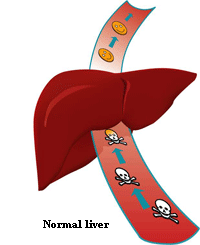
The liver is one of the largest organs in your body. It has many important jobs. It’s like a factory that makes vital substances (such as albumin and proteins that help with blood clotting). It cleanses the body of toxins (like alcohol) and bacteria. It produces bile that helps digest food. The healthy liver also gathers and stores important substances for your body to use later, such as fat, sugar, and vitamins. The liver can perform these tasks because millions of cells work as a team around the clock. Everything that enters the body through the mouth is digested in the stomach and intestines. These raw materials then enter the liver “factory” through the bloodstream and the liver cells break them down, purify them, make them into useful products, store some of them, and get rid of harmful products.
What is cirrhosis?
When something attacks and damages the liver, liver cells die and scar tissue is formed. This scarring is called fibrosis (pronounced “fi-bro-sis”), and it happens little by little over many years. When the entire liver is scarred, it shrinks and gets hard. This is called cirrhosis, and usually this damage cannot be undone. The liver is a unique organ and has the ability to regenerate (make its own new healthy tissue) but after development of too much scar tissue it will lose its ability to do so.
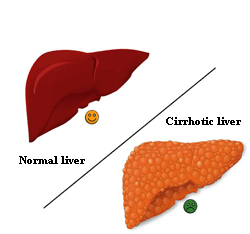
Any illness that affects the liver over a long period of time may lead to fibrosis and, eventually, cirrhosis. Heavy alcohol drinking and viruses (like hepatitis C or hepatitis B) are common causes of cirrhosis. However, there are other causes as well. A buildup of fat in the liver, called fatty liver disease, may lead to cirrhosis. Fatty liver disease may develop in people who are overweight and those with diabetes. Some people inherit genes for certain conditions that cause liver disease, such as genes that will cause iron buildup in the liver. In other diseases, bile collects in the liver and causes damage that can lead to cirrhosis. Other causes include certain prescribed and over-the-counter medicines, environmental poisons, and autoimmune hepatitis, a condition in which a person’s own immune system attacks the liver.
What happens when you have cirrhosis?

Because the liver becomes lumpy and stiff in cirrhosis, blood cannot flow through it easily. Pressure builds up in the vein that brings blood to the liver. This vein is called the portal vein and portal hypertension is the name of the condition when the pressure in the portal vein is high. To relieve this pressure, the blood passes through other veins. Some of these veins, called varices, can be found in the tube that carries food from your mouth to your stomach (the esophagus) or in your stomach itself.
When you have cirrhosis, the high pressure in the portal vein backs up into another organ called the spleen. The spleen then gets big and destroys more platelets than usual. Platelets are blood particles that help with blood clotting.
When you have cirrhosis, blood flow to the liver is reduced. Substances such as ammonia that would normally be cleaned by the liver, escape into the general circulation. In addition to the problems with liver blood flow, when cirrhosis is advanced there aren’t enough healthy cells to get all the work done. These cells cannot make the good substances such as albumin and clotting factors that the liver normally makes. Cirrhosis can also affect the ability to tolerate certain medications, which can result in side effects even in normal doses (MEDICATION SAFETY GUIDE). Liver cancer, called hepatocellular carcinoma (HCC), can also occur when some of the sick liver cells start to multiply out of control.
What are the symptoms of cirrhosis?
At first, you may have no symptoms at all (this is called compensated cirrhosis). In fact, a person may live many years with cirrhosis without being aware that their liver is scarred. This is because the pressure in the portal vein is not yet too high and there are still enough healthy liver cells to keep up with the body’s needs.
But if nothing is done to remove the cause of cirrhosis (if you continue to drink or your hepatitis is not treated, or you don’t lose enough weight, for example), the pressure in the portal vein gets higher and the few remaining liver cells get overwhelmed. Then you may notice symptoms like low energy, poor appetite, weight loss, or loss of muscle mass. You can also develop the following serious problems (this is called decompensated cirrhosis): (1) internal bleeding from large blood vessels in the esophagus, called bleeding varices; (2) a buildup of fluid in the belly, called ascites (pronounced “a-sigh-tees”); (3) confusion from the buildup of toxins in the blood, called encephalopathy (pronounced “en-sef-a-lop-a-thee”); or (4) yellowing of the eyes and skin, called jaundice.
As mentioned earlier, another serious complication of cirrhosis is liver cancer, which may occur in the compensated or decompensated stage. There may be no signs of liver cancer until the cancer has grown very large and causes pain.
What is Decompensated Cirrhosis?

If you experience any of the serious problems described below, your disease has progressed from compensated cirrhosis to decompensated cirrhosis. You are then at risk of dying from these life-threatening complications unless your sick liver can be replaced with a healthy liver (liver transplant).
- Bleeding varices (internal bleeding)
- Ascites (fluid in the belly)
- Encephalopathy (confusion)
- Jaundice (yellowing of eyes and skin)
We will describe each of these in more detail on the next few screens.
Bleeding varices (internal bleeding)
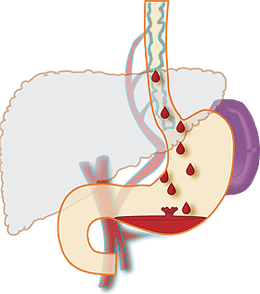
Large blood vessels (varices) in the food tube (esophagus) get bigger and bigger over time and can burst open. When this happens, you may vomit blood or notice your stool is black and tarry. If this happens, you should go to the emergency room immediately to get help and stop the bleeding.
The risk of bleeding from varices can be reduced by taking a particular type of blood pressure medicine (called beta-blockers) every day or by a special procedure in which tiny rubber bands are tied around the varices.
If you vomit blood or your stool turns black and tarry, you should go to the emergency room immediately. These are signs that varices may have begun to bleed. This can be life-threatening.
Ascites (fluid in the belly)

Ascites is another problem caused by high pressure in the veins of the liver. Fluid leaks out of the liver and into the belly, and your belly begins to fill up. This can make your abdomen enlarge like a balloon filled with water. Your legs and scrotum can get swollen too. This can be very uncomfortable. Eating can be a problem because you have less room for food. Even breathing can be a problem, especially when you are lying down. But the most dangerous problem associated with ascites is infection, which can be life-threatening. Ascites may go away with a low-salt diet, and by taking diuretics (water pills) ordered by your provider. But sometimes a provider must drain the fluid from the belly using a special needle.
If you have ascites and you suddenly get a fever or new belly pain, go to the emergency room immediately. These could be signs of a serious infection that can be life-threatening.
Encephalopathy (confusion)
A liver that is working poorly may not be able to get rid of toxic substances like ammonia (which comes from the intestines), and it may allow these substances to go into the brain and cause confusion. Besides confusion, toxins in the brain cause changes in your sleep, your mood, your concentration, and your memory. If it gets bad, these toxins can even cause sleepiness (in some cases, coma). These changes are all symptoms of hepatic encephalopathy. If you have encephalopathy, you may have problems driving, writing, and performing other activities of daily living. Signs of encephalopathy are trembling and hand “flapping.”
Encephalopathy may occur when you have an infection or when you have internal bleeding. It may also occur if you are constipated, take too many water pills, or take tranquilizers or sleeping pills. Your doctor might prescribe a medication called lactulose. Lactulose is a laxative syrup that makes your bowels move more often (up to two or three times a day) and helps get rid of ammonia. Your doctor might also prescribe rifaximin, an antibiotic.
If you are not acting like yourself, if you are confused, or if you are very sleepy, you should be taken to the emergency room immediately. These symptoms could be a sign of a serious medical problem. You should not drive when you have these symptoms.
Jaundice (yellowing of eyes and skin)
A liver that is working poorly cannot get rid of bilirubin, a substance that produces a yellowing of the eyes and skin called jaundice. Too much alcohol and some medicines can also lead to jaundice.
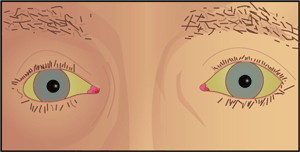
If you suddenly develop jaundice, you should go to the emergency room immediately.
How do you know if you have cirrhosis?
Often, you cannot know whether you have cirrhosis until the disease is advanced. Only your health care provider can tell you if you have cirrhosis.
There are many signs of cirrhosis that your provider may find. You may have red palms or small spider-like veins on your face or your body. You may have developed fluid in your abdomen.
Your provider may order blood tests that point to cirrhosis. Other tests can also give your provider a good idea of whether you have cirrhosis, such as an ultrasound, a CAT scan, an MRI, or a special kind of ultrasound that measures the amounts of stiffness in your liver (as the liver gets scarred, it gets stiffer).
Sometimes, you may need a liver biopsy. A liver biopsy shows how much scarring your liver has and will help your health care provider figure out what is causing the damage and how best to treat it.
What Will Your Health Care Provider Do About Cirrhosis?
People with cirrhosis need to see a health care provider regularly. If you have compensated cirrhosis, these visits may be scheduled as often as every 3 to 6 months. These visits allow your provider to watch for complications. Your provider may order the screening tests that can catch these complications early. Then they can be treated or even delayed.
If you have decompensated cirrhosis, you may need to see your provider more often so the complications that have developed can be managed.
An important step for all patients with cirrhosis is to reduce or prevent more liver damage by controlling the underlying cause. Patients who drink alcohol should stop all alcohol intake. It often takes support from friends, family and even a medical professional who specializes in helping individuals quit drinking. Patients with chronic viral hepatitis B or hepatitis C should receive treatment that can control or cure the virus. Patients with non-alcoholic fatty liver disease should reduce calorie intake. Consultation with a dietitian or with the MOVE! Weight Management Program is often recommended.
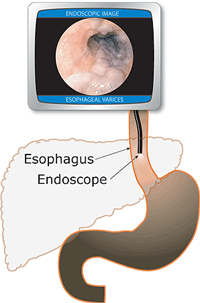
Some people with cirrhosis should have an upper endoscopy (pronounced “en-dahs-cup-ee”) procedure. This is a test in which a thin tube with a camera is passed down your esophagus (food tube) so that your provider can look for varices. If you have no varices, the endoscopy will be repeated every few years or you may be given a type of medication called a beta-blocker instead of endoscopy. If you have large varices, you will get treatment or medication to reduce the chance of bleeding.
You also will have a blood test and an ultrasound (or sometimes a CAT scan or an MRI) to look for signs of liver cancer and ascites. It is important for your health care provider to look for cancer on a regular basis, usually every 6 months. If the cancer is caught early, there are often ways to treat it.
If you have developed decompensated cirrhosis, your provider may discuss liver transplant with you. Your provider can answer questions and help you to decide if a transplant is right for you. Your provider will help you find out if your body can tolerate this operation, and, if it can, help you and your loved ones get ready for transplant surgery.
What can you do about your cirrhosis?
The most important thing you can do is to protect your liver from further damage and follow the treatment prescribed by your provider. The following checklist will help you take care of your liver and keep you well.
Put a check in the boxes next to the statements that show what you have done or are going to do to take care of your liver:
- I am not drinking alcohol or using drugs.
- I always take the medications that my provider has ordered for me. I know their names and purpose. SEE MEDICATION SAFETY GUIDE
- I tell my provider if I am taking over-the-counter or herbal medications.
- I don’t take pain pills like ibuprofen (Motrin®, Advil®) or Naprosyn (Aleve®), especially if I have ascites.
- I don’t take too many Tylenol® (acetaminophen) pills, and I never take Tylenol with alcohol.
- I avoid sleeping pills or tranquilizers.
- If my provider tells me to take lactulose, I take enough to move my bowels two or three times a day and the stool is a soft consistency.
- I keep all my medical appointments or call if I need to reschedule.
- I have been tested to see whether I need to get the hepatitis A and B vaccines (hepatitis A and B are viruses that attack the liver).
- I have received the pneumonia vaccine and I get my annual flu shot (people with cirrhosis are more likely to get infections).
- I have received or inquired about the COVID vaccination.
- I eat a well-balanced diet that is low in fat and includes enough protein. I cut down on salt (sodium), read food labels, and avoid canned or prepared foods, especially if I have ascites.
- I never let myself get constipated. If it happens, I tell my health care provider.
- I keep a healthy weight and weigh myself regularly if my provider recommends it.
- I make sure to have a balance of work, rest, and exercise in my life.
- I cope well with stress (or I ask for guidance when I can’t cope).
- I tell my health care provider if I am depressed.
- I have never smoked cigarettes, I have quit smoking, or I have discussed quitting with my health care provider.
- I have asked my health care provider whether I need a liver transplant.
When to go to the emergency room
Use the following guidelines to determine if you need to go to the emergency room.
DANGER
GO TO THE EMERGENCY ROOM! (or call 911, say you have cirrhosis, and tell them what is happening)
BLEEDING: My stools are black and tarry. I'm vomiting blood.
CONFUSION: My head is cloudy. I'm so confused and sleepy I can't do anything.
FEVER: I have a fever and I can't stop shaking.
JAUNDICE: My eyes are suddenly turning yellow.
What You and Your Provider Should Do to Take Good Care of Your Liver
You and your provider can do the following things to keep your liver as healthy as possible for as long as possible. (Take this list with you to discuss with your provider.)
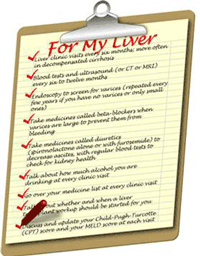
- Control or remove the cause of the liver injury (for example: stop drinking alcohol, treat hepatitis, lose weight)
- Schedule liver clinic visits every 6 months; more often if you have decompensated cirrhosis.
- Have blood tests (to see how well the liver is working and to check for liver cancer) and an ultrasound (or CT or MRI) every 6 months.
- If appropriate have an endoscopy to screen for varices (repeated every few years if you have no varices or only small ones).
- Take medicines called beta-blockers when prescribed, to reduce the chance of decompensation.
- Take medicines called diuretics (spironolactone alone or with furosemide) when prescribed, to decrease ascites, and have regular blood tests to check for kidney health.
- Talk about how much alcohol you are drinking at every clinic visit.
- Review your medication list at every clinic visit.
- Talk about whether and when a liver transplant workup should be started for you.
- Discuss and update your Child-Pugh score (also known as CTP score) and your MELD score at each clinic visit. These scores are ratings that tell how sick your liver is and how urgently you need a transplant.
Medication Safety for Patients with Advanced Liver Disease
Developed by the Hepatology FAB Cirrhosis Sub-board and approved by the Hepatology FAB | September 2022
When you have advanced liver disease or cirrhosis, some prescription or over-the-counter medications can harm you, especially if your liver disease is complicated by ascites (fluid build-up in the belly), encephalopathy (confusion), esophageal varices (swollen blood vessels in the area that connects the mouth to the stomach) or kidney problems. Make sure you bring a list of , to your every visit! Please see more information below:
| Pain medications | When and how are they safe to take | Be careful! | Do not take! |
|---|---|---|---|
| Acetaminophen (Tylenol) | Safest to take up to a total daily dose of 2000 mg/day (such as 4 extra-strength pills). AVOID ALL ALCOHOL | Check labels carefully of ALL pain medications you take, as they can have acetaminophen! | Acetaminophen can damage your liver if you take more than the recommended amount or if you drink alcohol while taking this medication. Acetaminophen in different types of pain medications can add up! |
NSAIDs Ibuprofen (Motrin, Advil), Naproxen (Aleve), Diclofenac, Indomethacin (Tivorbex /Indocin) | Discuss with your gastroenterologist/ liver provider | Inappropriate use may result in:
| DO NOT TAKE any NSAIDs if you have ascites (fluid build-up in your belly) or kidney problems. Discuss with your providers about alternative treatments. Acetaminophen is the preferred over-the-counter pain/fever reducing medication (see above) |
| Many cold and flu medications have acetaminophen and/or NSAIDs — check the label! | |||
Narcotics/opiates: | Use only if absolutely necessary and for the shortest duration possible. Requires close monitoring. May require laxatives to avoid constipation | Best to avoid, as they may cause increased sleepiness and confusion | DO NOT TAKE if you have been diagnosed with hepatic encephalopathy and take meds such as lactulose, rifaximin. Avoid especially if you had a recent hospitalization for hepatic encephalopathy. Discuss alternative treatments with your provider |
| Sedatives/sleeping aids | When and how are they safe to take | Be careful! | Do not take! |
|---|---|---|---|
| Lorazepam (Ativan), Alprazolam (Xanax), Diazepam (Valium), Diphenhydramine (Benadryl, Tylenol PM), Doxylamine (Unisom), Zolpidem (Ambien), Zaleplon (Sonata), Eszopiclone (Lunesta), Ramelteon (Rozerem), Lemborexant (DayVigo), Suvorexant (Belsomra) | If you have NO complications of cirrhosis, use the lowest effective dose for the shortest time possible | Best to avoid, as they may cause increased sleepiness and confusion | DO NOT TAKE them if you have hepatic encephalopathy (and take medications such as lactulose, rifaximin), especially if you have had a recent hospitalization for hepatic encephalopathy |
| Antacid medications (for acid reflux or stomach symptoms, or for stomach ulcers) | When and how are they safe to take | Be careful! | Do not take! |
|---|---|---|---|
| Famotidine (Pepcid), Calcium carbonate (Tums), Aluminum hydroxide/magnesium hydroxide (Maalox), Calcium carbonate/magnesium hydroxide (Mylanta) | Generally safe to use. Talk to your provider regarding how long you are expected to take these medications, in order to reduce the number of pills you take and avoid potential interactions with other medication | ||
|
PPIs (proton-pump inhibitors) Omeprazole (Prilosec), Lansoprazole (Prevacid), Pantoprazole (Protonix), Esomeprazole (Nexium), Rabeprazole (Aciphex), Dexlansoprazole (Dexilant) | They should be used for a very clear indication, the lowest dose and shortest time | May increase risk for fractures, kidney disease, and infections | DO NOT TAKE them or use them for a very short time if you have ascites and/or hepatic encephalopathy |
Commonly used terms in cirrhosis
These are the medical terms (in alphabetical order) that you may read in this handbook, hear in discussions with your provider, or read in articles about cirrhosis on the Internet or in printed materials.
- AFP (alpha-fetoprotein): A tumor blood test. High levels of AFP may be a sign of liver cancer.
- Albumin: Important protein made by the liver. Too little of it in the blood is a sign that the liver is not working well.
- Ammonia: A by-product of the digestion of protein in the gut that is toxic if not filtered by the liver.
- Ascites: Fluid in the belly.
- Asterixis: Flapping movement of the hands that happens when the brain is affected by toxins (like ammonia) that are not being removed by the sick liver.
- Beta-blockers: Medicines (like carvedilol, propranolol, and nadolol) that lower the pressure in the portal vein and reduce the chance of bleeding from varices.
- Bilirubin: By-product of the body that is removed by the liver. A high level in the blood causes jaundice and is a sign that the liver is not working well.
- Child-Pugh (or CTP) score: A score that indicates how sick the liver is. Based on this score, there are three Child-Pugh stages: A (when the liver is still working very well); B (when the liver is working so-so); and C (when the liver is working poorly). If you are Child-Pugh B or C, you should be considered for a liver transplant.
- Cirrhosis: Scarring of the whole liver that makes it shrunken and hard. Cirrhosis is the result of something (like alcohol, a virus, or fat) that damages the liver for a long time.
- Creatinine: Blood test that measures how well your kidneys are working. It can be high when you are taking a dose of diuretics (water pills) that is too high or when your liver is very, very sick.
- CT (or CAT) scan: A type of X-ray that takes pictures of your liver and can be used to look for liver cancer and other problems such as ascites.
- Diuretics: Water pills such as spironolactone (Aldactone®) and furosemide (Lasix®) that are used to help the body get rid of ascites and swelling of the legs.
- Encephalopathy: Changes in brain function that happen when toxic substances (like ammonia) are not filtered by the liver.
- Endoscopy: A test of your esophagus and stomach in which you will swallow a thin tube with a camera. It is used to look for varices.
- Esophagus: Tube that carries food from your mouth to your stomach.
- Hemoglobin and hematocrit: These blood tests will be very low if you have internal bleeding.
- INR (also referred to as prothrombin time): Test that checks how fast your blood clots. When your liver is not working well, your blood takes longer to clot and this test result will be high.
- Jaundice: When your eyes and skin turn yellow. It is a sign that the liver is not working well. You can also become jaundiced if your bile ducts are blocked.
- MELD score: A score that is used to rank the urgency for liver transplant. The worse your liver works, the higher your MELD score and the higher your position on the transplant list.
- MRI: A type of test that takes pictures of your liver and can be used to look for cancers or other problems.
- Portal hypertension: Increased pressure in the vein that takes blood to the liver. This is the main consequence of having cirrhosis.
- Platelets: Particles in the blood that help the blood to clot. The platelet count is low in cirrhosis, and this may be the earliest sign of cirrhosis.
- Portal vein: Vein that takes blood from the intestines to the liver.
- Sodium and potassium: Electrolytes (pronounced "ee-lek-tro-lights") that must be checked often whenever your health care provider prescribes water pills.
- Spider angiomas: (Pronounced "an-gee-o-mas.") Tiny veins that look like little red spiders on your face, chest, and arms. They are signs of cirrhosis.
- Transplant of the liver: Major surgery by which a diseased liver is replaced with a healthy liver.
- Ultrasound: A type of test that uses sound waves to take pictures of your liver. It is used to look for tumors and other problems.
- Varices (esophageal, pronounced "ee-sahf-a-gee-ul"): Enlarged veins in the esophagus that can burst open and lead to vomiting blood or having black stool.
Resources for More Information About Cirrhosis
Here are some information sources you can trust if you want to know more about liver disease and its treatment:
- http://www.hepatitis.va.gov
This VA website is an excellent source of information about liver disease and cirrhosis. - http://www.liverfoundation.org

The American Liver Foundation’s site. It provides information and links to Federal and VA benefits and resources. - https://cirrhosiscare.ca

This website was created as part of the Cirrhosis Care Alberta project. It is a wonderful resource for both patients and families.




















